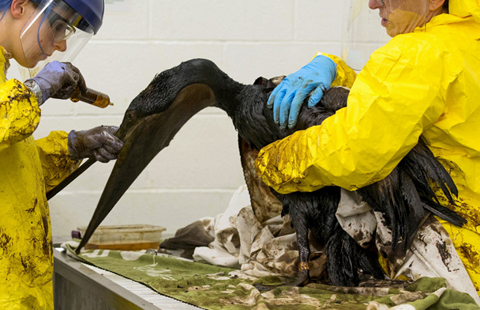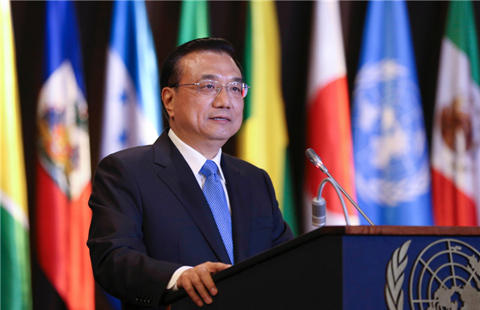An Interview on China's Construction Activities on the Nansha Islands and Reefs
Updated: 2015-05-27 01:00
By Zhang Yunbi(China Daily)
|
||||||||
On 26 May 2015, Mr. Ouyang Yujing, Director-General of the Department of Boundary and Ocean Affairs of the Ministry of Foreign Affairs of the People's Republic of China, received a written interview by journalists from China Daily on China's construction activities on some garrisoned islands and reefs of the Nansha Islands. The full text of the interview is as follows:
1. Why is China conducting construction activities on the Nansha islands and reefs? What are the purposes? Does China intend to increase military presence in the South China Sea as other parties have argued?
China's construction activities on the Nansha islands and reefs are aimed at first and foremost improving the working and living conditions for personnel stationed there and better fulfilling China's relevant international responsibilities and obligations. It needs to be emphasized that the Nansha Islands is China's territory, and China has every right to deploy on relevant islands and reefs necessary facilities for military defense. However, the facilities on relevant islands and reefs are primarily for civilian purposes.
China is committed to a path of peaceful development, a defense policy that is defensive in nature and a foreign policy of building friendship and partnership with her neighbors. Therefore, China is a staunch force for peace and stability in the region. China has signed with ASEAN countries the Declaration on the Conduct of Parties in the South China Sea (DOC), acceded to the Treaty of Amity and Cooperation in Southeast Asia (TAC), and undertaken to peacefully resolve differences or disputes with countries directly concerned through negotiation or consultation without resorting to the threat or use of force. On the South China Sea issue, China is always committed to resolving relevant disputes through negotiation and consultation with countries directly concerned on the basis of respect for historical facts and international law, and making joint efforts with ASEAN countries to maintain peace and stability in the South China Sea.
2. What civil and public facilities will China develop on the islands and reefs? What services will be provided to the region and the international community?
The Nansha Islands is in a distant sea area with busy shipping routes and vulnerable to marine perils. One of the important purposes of China's construction activities on the islands and reefs is to fulfill her relevant international responsibilities and obligations, such as maritime search and rescue, disaster prevention and mitigation, marine scientific research, meteorological observation, ecological environment preservation, safety of navigation and fishery production, and to provide necessary services to vessels from China, her neighbors and other countries sailing in the South China Sea. To that end, it is necessary to build runway, pier, telecommunication, meteorological, navigation safety, and environmental observation facilities, etc.
3. China has been emphasizing the civil and public nature of her construction activities. Will the facilities to be developed be open to the international community?
The primary purpose of China's construction activities on the Nansha islands and reefs is to better fulfill her relevant international responsibilities and obligations. When conditions are ripe, China will invite relevant countries and international organizations to use relevant facilities for cooperation in maritime search and rescue as well as in other areas. China will make overall plans about what facilities to be open to the international community based on comprehensive planning after the completion of development.
4. Some believe that China's construction activities on the islands and reefs are aimed to intensify the legal status of the Nansha Islands and the country's claim on the dotted line. What is your comment?
China's sovereignty and relevant claims of rights in the South China Sea have been formed in the long course of history and upheld by successive Chinese governments. This position has adequate historical and legal basis. There is no need to have it strengthened through construction activities on relevant islands and reefs.
5. Will China's construction activities on the islands and reefs do harm to the ecological environment in the South China Sea? What steps has China taken to mitigate the impact on the environment?
The Nansha Islands is China's territory. No one cares more than China about the ecological preservation of relevant islands, reefs and sea areas. It needs to be pointed out that China's relevant construction project has gone through science-based evaluation and assessment, with equal importance given to construction and protection. We have taken into full account issues of ecological preservation and fishery protection, followed strict environmental protection standards and requirements in the construction process, and adopted many effective measures to preserve the ecological environment. We will further step up our efforts of ecological monitoring and preservation on the relevant islands, reefs and waters. In addition, as a State Party to the United Nations Convention on Biological Diversity (CBD) and the United Nations Convention on International Trade in Endangered Species of Wild Fauna and Flora (CITES), China will strictly observe provisions of the conventions and honor her obligations in good faith.
6. Will China's construction activities on the islands and reefs affect freedom of navigation and overflight in the South China Sea? Will China establish an Air Defense Identification Zone (ADIZ) in the South China Sea once the construction activities are completed?
Freedom of navigation and overflight in the South China Sea that countries enjoy in accordance with international law has never been affected because of the relevant disputes in the South China Sea. China's construction and maintenance of facilities on some garrisoned islands and reefs of the Nansha Islands will help improve the capacity of China and the international community in maritime search and rescue, meteorological observation and safety of navigation. It will not undermine countries' freedom of navigation in the South China Sea. On the contrary, it will facilitate joint response to challenges on the sea and provide more guarantee for safety of navigation.
China has the right to establish an ADIZ. This has nothing to do with territorial or maritime disputes. Whether China will set up an ADIZ in the South China Sea depends on whether and to what extent the security of airspace is threatened as well as other factors. Currently, the situation in the South China Sea is stable on the whole. China and ASEAN countries are committed to the full and effective implementation of the DOC in an effort to maintain peace and stability in the South China Sea.
7. Are China's construction activities on the islands and reefs a response to the arbitration initiated by the Philippines concerning the South China Sea and to influence the proceedings by the arbitral tribunal?
China has indisputable sovereignty over the Nansha Islands and their adjacent waters. The construction activities there are within China's sovereignty and have nothing to do with any other matters. China does not accept or participate in the arbitration initiated by the Philippines. This is the position of the Chinese government, fully supported by international law.
8. Some say China's construction activities on the islands and reefs contravene the DOC. Is this the case?
China is committed to the full and effective implementation of the DOC and respects and abides by the principle, spirit and provisions of the DOC. China's construction activities on relevant islands and reefs in Nansha are lawful and justified, and do not run counter to the DOC.
It must be pointed out that the DOC applies to China as much as to ASEAN countries concerned. A certain country, in disregard of the DOC, has been acting provocatively to infringe on China's rights and interests and obstruct practical cooperation within the framework of the DOC. Its unilateral initiation of arbitration complicates and escalates the disputes in the South China Sea and jeopardizes peace and stability in the South China Sea. China calls on parties concerned to work with the Chinese side to ensure the full and effective implementation of the DOC and stay committed to the "dual track approach" to properly handle the South China Sea issue and manage the differences, so as to promote joint development and practical maritime cooperation and contribute to peace and stability of the region and to sound growth of China-ASEAN relations.
9. China has been stressing that her construction activities on the islands and reefs are lawful, reasonable and justified. But why does China criticize other countries for their construction activities on the islands and reefs?
The Nansha Islands has been an inseparable part of China's territory since ancient times. It is within China's sovereignty to conduct construction activities on her own islands and reefs, which are lawful, reasonable, justified and beyond reproach. Since the 1970s, the Philippines and some other countries have illegally occupied and then engaged in massive construction on some islands and reefs of China's Nansha islands. It has seriously violated China's territorial sovereignty, the Charter of the United Nations and the basic norms governing international relations. China is firmly against such moves. The construction activities by China and those by these countries are totally different in nature. China urges the Philippines and other countries to immediately withdraw their personnel and facilities from the islands and reefs they have illegally occupied, and immediately stop all activities that undermine China's territorial sovereignty and her legitimate rights and interests.
10. Some countries say China's construction activities outpace and outsize those by other countries in the South China Sea. What is your response?
China is a big country that shoulders more international responsibilities and obligations. China is conducting construction activities at a pace and with a scale as befitted her international responsibilities and obligations in the field of search and rescue, disaster prevention and mitigation, meteorological observation, ecological conservation, navigation safety and fishery services. These activities are designed to serve practical needs and provide better services to the ships of China, her neighbors and other countries whose ships and boats pass through the South China Sea.
11. Do China's construction activities on the islands and reefs signal a shift in her policy regarding the South China Sea?
It is China's consistent strategy to uphold peace and stability in her neighborhood. China is the last country that wants to see chaos in the South China Sea. Still less will China do anything to stir up troubles. While working to maintain her territorial sovereignty and maritime rights and interests, China will stay committed to the basic policy of upholding peace and stability in the South China Sea and the fundamental solution to the South China Sea issue through negotiation and consultation. China seeks to effectively manage differences by fully and effectively implementing the DOC and formulating a Code of Conduct (COC) and other institutions and rules. Pending the final solution, China will pursue the win-win approach of joint development and maritime cooperation. Such is China's policy on the South China Sea issue, a policy that shall not and will not change.

 California oil spill takes toll on marine mammals
California oil spill takes toll on marine mammals
 Ten photos you don't wanna miss - May 27
Ten photos you don't wanna miss - May 27
 Family photos for mountain-dwellers
Family photos for mountain-dwellers
 A young part-time chauffeur on the road
A young part-time chauffeur on the road
 Death toll from heat wave in India nears 800
Death toll from heat wave in India nears 800
 Tech giants shine on Intl Big Data Expo 2015
Tech giants shine on Intl Big Data Expo 2015
 Premier Li urges production capacity co-op between China, LatAm
Premier Li urges production capacity co-op between China, LatAm
 US honors war dead on Memorial Day
US honors war dead on Memorial Day
Most Viewed
Editor's Picks

|

|

|

|

|

|
Today's Top News
China cautions US over
South China Sea
China, Cuba emphasize confidence
Storms kill 16 in Texas, Oklahoma; Houston flooded
Obama to host South Korea's Park in mid-June
California oil spill takes toll on marine mammals
China issues first white paper on military strategy
China, Chile ink multi-billion-USD currency swap deal
Cleveland, US Justice Dept reach settlement over police
US Weekly

|

|






